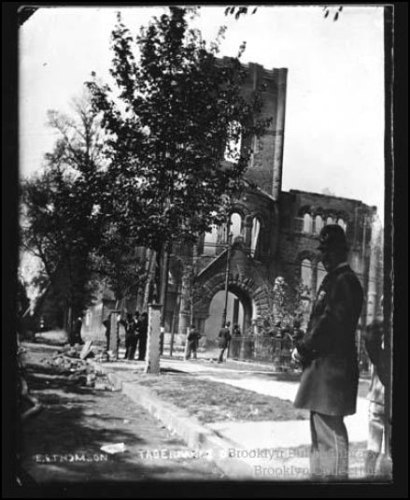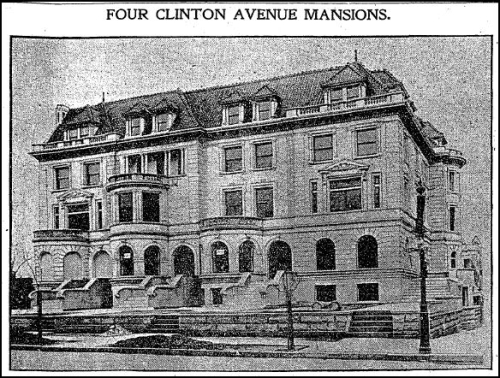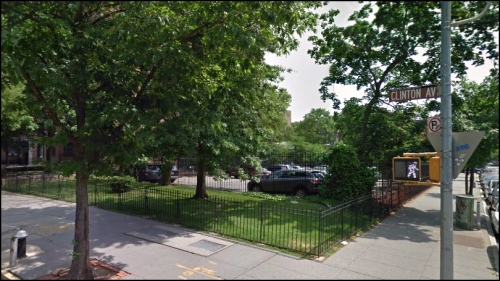Walkabout: Rev. Talmage’s Tabernacle, Part 5
Read Part 1, Part 2, Part 3, and Part 4 of this story. On a spring Sunday morning, right after church services, on May 13, 1894, the great organ of the Brooklyn Tabernacle burst into flames. Within a matter of minutes, the fire spread to other parts of the church, like a flame going through…


Read Part 1, Part 2, Part 3, and Part 4 of this story.
On a spring Sunday morning, right after church services, on May 13, 1894, the great organ of the Brooklyn Tabernacle burst into flames. Within a matter of minutes, the fire spread to other parts of the church, like a flame going through a match box, and by the end of the day, the entire church was a burned out ruin.
Not only did the fire destroy the third incarnation of the Brooklyn Tabernacle, it also destroyed the brand new Regent Hotel right next door, as well as caused damage to at least twelve other buildings in the immediate vicinity, including another church a block away. It was a conflagration of Biblical proportions, fed by flammable materials and a strong wind that blew burning cinders for blocks.
The church was called “Talmage’s Tabernacle” after its famous preacher, who had turned the church around, in less than twenty years, from a twelve member congregation to a mega-church with almost 3,000 members and another 2,000 weekly guests.
The Reverend Doctor Thomas DeWitt Talmage had the gift of oratory, like no one else in Brooklyn since the great Rev. Henry Ward Beecher, and a Sunday service in his church was a spiritual, theatrical and musical experience that couldn’t be missed.
But all was not well in the Tabernacle. Over the years, as the church grew, so too did controversy. The first and second Tabernacles also burned down, both on a Sunday, in suspicious circumstances. Each time, the church rallied around Talmage, and rebuilt.
As the congregation grew, so too did Talmage’s power and influence, both in and outside of the church, and there were power struggles between himself and his Board of Trustees, and his superiors in the Presbyterian Church hierarchy. Talmage was actually put on trial by the Presbytery, to answer to charges of falsehood and lying. He was acquitted, and became more popular than ever.
Most importantly, there were money problems. Really big money problems. The building of the third Talmage Tabernacle, this huge church on the corner of Clinton and Greene Avenue, in Clinton Hill, had severely strained the coffers of the church.
They couldn’t afford to build the church, couldn’t afford to pay workmen, or other professionals commissioned to work on the new church. Talmage had wanted the most splendiferous church ever, with fantastic interior detail, and the second largest and most expensive pipe organ in North America.
No expense was to be spared, but the problem was there was no money to pay for this splendor. The Trustee Board, which handled the finances, struggled to find money, and the new church was mortgaged and borrowed against, quite up to the beautiful rafters.
Talmage couldn’t handle it. He went on long lecture tours across the US and Europe, and distanced himself from the financial problems, telling both his congregation and reporters that it was too much for him to shoulder, and was distracting him from his Important Work.
He then threatened to quit, taking two weeks to decide to stay, while his harried Trustees called in all of their favors to borrow more money. Somehow they found it, and Talmage stayed. And then the church burned down.
After the fire, while the ruins were still smoking, Talmage announced he was leaving town for his speaking engagements on the Continent and in Australia. In a long rambling letter to his congregation, reprinted in full in the Brooklyn Eagle on June 9th, 1894, Talmage spoke of the cleansing fire that consumed the buildings of man.
He questioned if some of his congregants weren’t idolizing the building itself, placing too much importance and glory on its splendid appearance and its mighty organ. He spoke rapturously of that incredible musical instrument, eulogizing it thus: “An organ that was a hallelujah set up in keys and banked in pipes, waiting for a musician’s manipulation that would lead a congregational song as an archangel might lead heaven.
Glorious organ! When it died down into the ashes of that fire perhaps its soul went up where Handel and Hayden began to play on it.” The man could certainly turn a phrase. He could also turn his back on the people who had supported him and made him who he was.
He wondered if the fires weren’t a lesson meant for him – God telling him that he should be more humble. He told of his meetings with presidents and kings, and trips that took him to the corners of the earth, and how he, a mere farm boy, had risen in the world.
“There was a danger that I might become puffed up and my soul be weakened for future work,” he said. He ended by saying that perhaps God was cleansing his most important instruments, the people of the Brooklyn Tabernacle, by fire, to make them stronger and better.
He didn’t know what God had planned, but he was confident that it would be revealed to them. He would not be there to see the plan, as he was on his way to Australia. He officially resigned on November 5, 1894.
Of course, Talmage couldn’t see the irony or the hubris here. What of the destruction of two buildings, the fearful and near-death experiences of the guests of the Regent Hotel, next door to the church, many of whom escaped with only the clothes on their backs, and the damage to many other structures in the neighborhood?
The hundreds of thousands of dollars of damage, not to mention the lives of the firemen, who astonishingly saved the rest of the block and neighboring buildings, and all he could think of is that God allowed all that in order to teach him humility? The lesson was certainly not learned.
In the aftermath of the fire, the most astonishing revelation of all emerged. The interior walls and ceilings of the Tabernacle were not plaster, or fire-resistant asbestos, or even wood, as was thought. They were a manufactured wall covering called “artificial lumber”.
And what was artificial lumber? Macerated straw pulp and pine resin, heated and pressed into boards and decorative ornament, which could then be painted. A super thick, Lincrusta-like wall treatment. You can’t get more flammable than that.
Added to that, the gorgeous and magnificent organ, with its over 4,400 pipes, channeled the heat and fire through the building like an array of chimneys, funneling the fire like a bellows. Plus, the church had large swaths of heavy velvet curtains and draperies, especially near the altar and organ. It was a perfect storm.
The Trustees and church members met to decide what to do next. They considered rebuilding, and finding a new preacher. The congregation met at a local theater for services, and their interim pastor read an encoouraging letter from Rev. Talmage, who was on the road.
Only 300 people showed up, and when the letter was read, it was met with dead silence. The congregation of the Tabernacle slowly broke up, with members joining other churches. The Trustees stayed together, to wrap up business, and the burned out hulk of the church became almost as much a neighborhood draw as the church had been.
In August of 1895, Talmage’s wife of over thirty years, Susan Whittemore Talmage, died. The family still lived at 1 South Oxford Street. Mrs. Talmage was much loved, and her funeral brought her husband back to Brooklyn for the first time in years.
Her coffin was carried into the Lafayette Avenue Presbyterian church by several members of the Tabernacle Trustee Board. According to witnesses, her last words to her husband were “I’m going to heaven.”
Susan Talmage had been from a wealthy Greenpoint family, and at her death, Talmage received her fortune, setting him up financially for life. He would later cause eyebrows to rise by marrying again, only three years later, in 1898, to Eleanor Collier, a 40 year old widow. Talmage was 67 at the time, the father of five grown children.
After lecturing on the road for a few years, Talmage decided to go back to pastoring a church, and became the associate pastor of First Presbyterian Church in Washington DC. He brought in large crowds, but nothing like the ones he had had in Brooklyn, times were changing, and his style of preaching was no longer as popular.
In 1898, he resigned to dedicate his time to writing about religion. His writings, published in magazines, journals and newspapers, reached millions, and are still studied in divinity schools and seminaries. In 1902, he was vacationing in Mexico when he caught influenza.
He returned to Washington seriously ill, and died from inflammation of the brain on April 12, 1902. His funeral was a quiet one, and his family received condolences from all over the world. Reverend Talmage is buried in the family plot at Green-Wood Cemetery.
A few years before, in 1899, the property upon which the Tabernacle and the Regent Hotel had stood was sold to Henry B. Moore, a builder. His architect, Herbert B. Brewster, designed four Renaissance Revival limestone houses on the site, which were completed in 1901.
They were described in the Eagle as the highest in quality, and the largest corner house and its neighbor were sold to Daniel P. Morse and his son, Manhattan based shoe manufacturers. An illustration accompanied the article, showing fine looking houses.
These houses were in turn, torn down in the 1940’s, in order to build housing for the Navy Yard officers, during World War II. Today, these buildings are co-ops, and the Tabernacle grounds are now part of the parking lot.
Adding insult to injury, the cornerstone of the second Tabernacle, which stood on Schermerhorn Street, was turned into a hitching post, which stood somewhere on Bedford Avenue, where it was noticed by the Brooklyn Eagle in 1899. The stone listed the dates of the two churches, both consumed by fire, the rest of their stones scattered across Brooklyn.
The question remains. Did Rev. Talmage start any or all of these fires? All happened on a Sunday, when he was there. Did he set the first two to force his congregation to build larger and better churches? The third fire was a result of faulty wiring in the organ.
Was it carelessness, or a bold attempt to get the church out of debt? They were, after all, holding a massive amount of debt. An investigation would be carried out to see if this highly flammable material had been in the plans, and if the Buildings Department had approved it.
Or had a cheap switch been made, figuring no one would ever know? Or was Talmage’s ego so big that he thought he could be God’s instrument of cleansing fire? Who had authorized the flammable building materials? Someone had to know it was up there. We’ll never know. GMAP









The reverend was a firebug.
He took the fire and brimstone thing too literally.